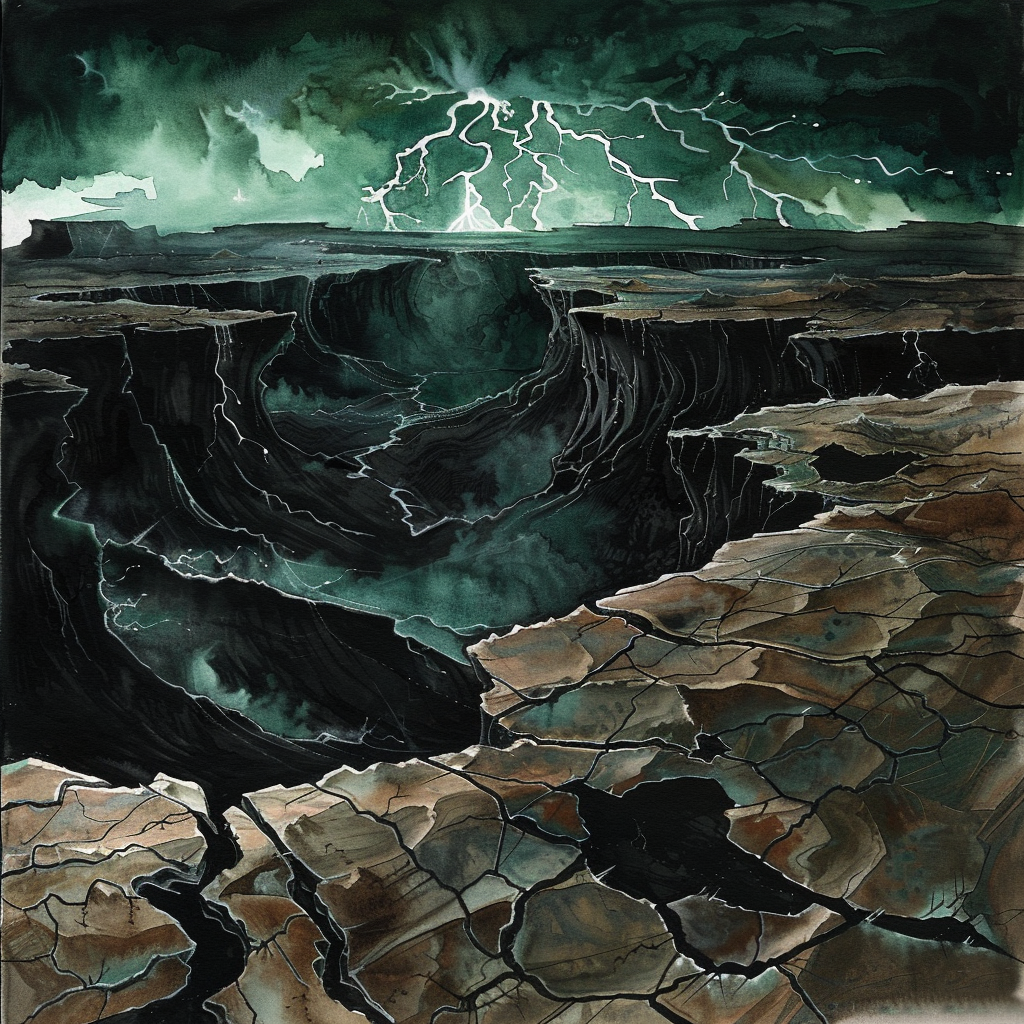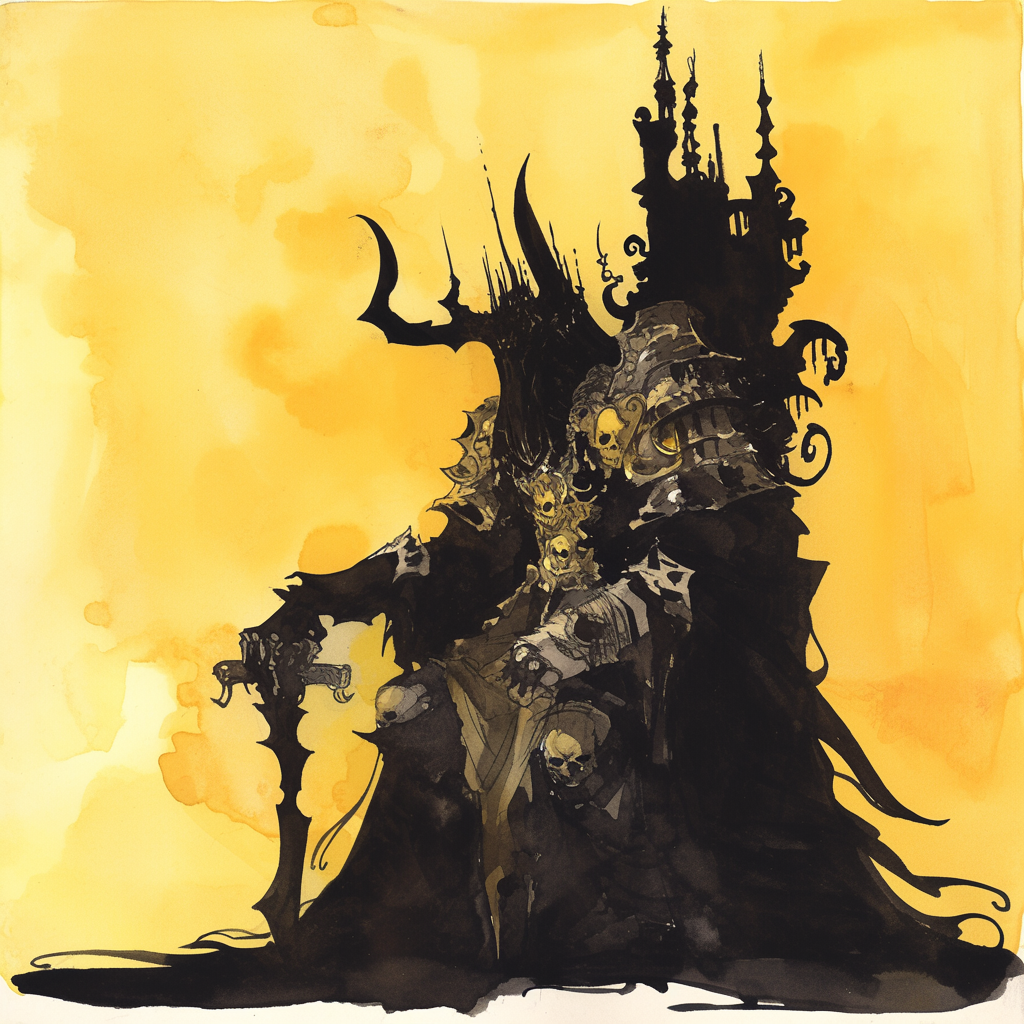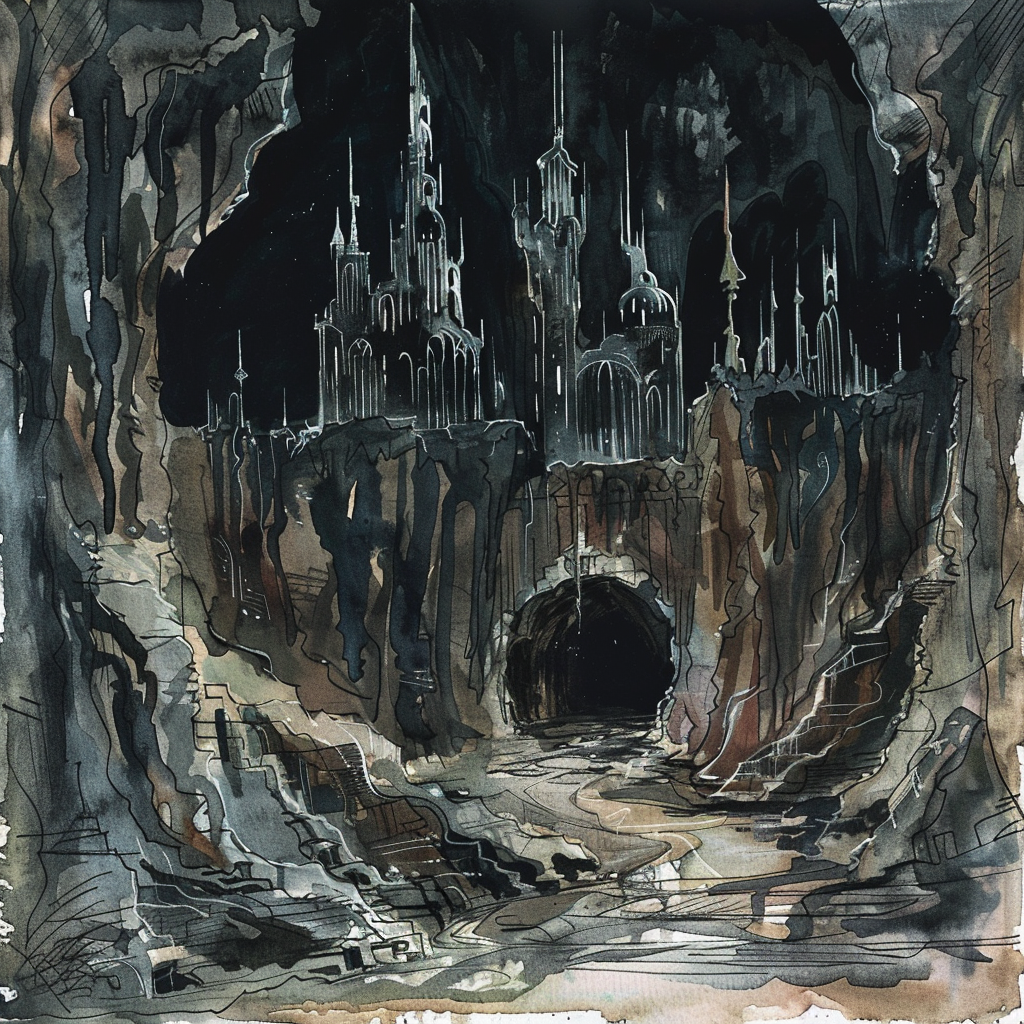[ Baator ] [ Avernus | Dis | Minauros | Phlegethos | Stygia | Malbolge | Maladomini | Cania | Nessus ]
Nessus
Baator — Layer the Ninth
The Hell of Pride, the Nadir, the Darkest Depths of Hell, the Endless Chasm of Nessus
Themes of the Layer: Nessus embodies the sin of pride in its most absolute and terrifying form, every feature and denizen reflecting the dark majesty and consuming arrogance of its overlord. The layer’s a vast, labyrinthine landscape of jagged tunnels and bottomless chasms, all centred around Malsheem. This citadel’s designed to intimidate and awe, with its impossibly high spires, colossal gates, and infernal carvings that commemorates the victories of the baatezu and glories in the subjugation of their enemies.
Nessus is a realm of isolation, reflecting the solitary nature of true pride. Asmodeus’ citadel, though grand, is a place where he broods alone, separated from even his closest lieutenants by layers of secrecy. The nature of Nessus also issues a warning against hubris. The layer is filled with the grim remains of those who dared to challenge the Dark Lord and failed. Colossal statues of fallen arch-devils, their features twisted in agony, stand as reminders of the cost of overestimating oneself. Yet, beneath its surface, Nessus also reveals the false glory of pride. The splendour and majesty of Malsheem and its surroundings are but a façade, hiding the rot and decay that lie beneath. The grandeur of the layer masks the suffering and torment of countless souls: The true price of Asmodeus’ prideful reign.
The Surface

At the deepest, darkest, most wicked part of Baator, lurks Nessus the Nadir. The final layer of the Nine Hells is, on the surface at least, a blasted and desolate wasteland. It is scoured by ill winds which carry the very darkest of whispers, the curses of the most damned souls and the threats and lies of the most malevolent entities. No vegetation, structures or even hills clutter the utter despair of this landscape of cracked black rock. The big sky is a dull green-blue, shattered by frequent bursts of black lightning from the unceasing storm. The coruscation and acidic rain have blasted the whole of the surface sterile of any kind of life; not a single blade of grass or scrawny weed can be found in this long-dead layer.
If a cutter doesn’t fancy taking their chances with the weather, the barren mesa is riddled with cracks, fissures and canyons, ranging from metres to many leagues deep. It’s in these sinister depths that all the creatures of Nessus lurk. In some places, jagged black spires of rock reach up towards the sky, remnants of long-forgotten infernal structures. These crumbling monuments are all that has withstood the destructive forces that constantly lash the surface.
The overall impression is one of utter hopelessness and despair. It’s a place devoid of life, beauty, or even the comfort of silence. The relentless tempests, the cracked and barren landscape, and the ever-present sense of malevolence make the surface of Nessus a truly terrifying place to find yourself. And yet somehow, it only gets worse below the surface.
The Deeps

A labyrinth of gorges, canyons and tunnels criss-cross at all levels, before twisting off again on solitary paths. The little light that reaches the depths is an eerie blue-green, a reside from the flickering lightning storms on the surface. A dull continuous rumble can be heard down here, as thunder reverberates along the tunnels. Navigating down here is a job for true bloods, as in the dim light one landmark blurs into another. Maps exist—and are illegal to possess—although they’re hard to comprehend because the tunnels intersect in three dimensions. While bridges across canyons exist, they’re invariably guarded by baatezu loyal to the Dark Lord. They’re also rarely straightforward to cross, with no luxuries like handholds or walls to save the wary traveller from the drop into the darkness below. A perceptive cutter might be able to make out flickering black lights in the deep, or even hear distant echoing machinery, rituals or screams. The acrid air here is stale and dead; cutters who need to breathe be warned. If your lungs are stinging, that’s a good sign. It’s when you can’t feel anything at all, that’s when you should start to worry.
The deep places of Nessus are a study in extremes: the coldest pits of deathly black ice, the hottest brimstone volcanoes, the steepest and smoothest cliffs. Waves of fire hundreds of feet long regularly sweep through the tunnel regions turning everything in their path to ash. Only the most foolhardy of travellers would dare to venture here.
The Dark Lord

Ah, Asmodeus. The very name sends shivers down the spines of the most hardened planewalkers and seasoned adventurers. To call him merely the Lord of the Ninth Layer is an understatement; he’s the King of Hell, the Overlord of Baator, the epitome of cunning and malevolence. Wise cutters don’t use his name, instead referring to the ‘Dark Lord’, or one of his many other monikers. He’s said to be the most handsome of the arch-devils, a fact in which he takes great pride. His appearance part dark allure and part sinister charm. But don’t let the devilish good looks fool you—his beauty masks a heart as black as the void and a mind sharp enough to best even the gods. The chat goes that when the Dark Lord chooses to reveal his true nature, his beauty transforms into a visage of ultimate evil. His eyes can pierce through the soul, exposing the deepest fears and darkest secrets of any who dare meet his gaze. He exudes an aura of command and menace that brings the mightiest fiends and celestials to their knees.
The Dark Lord is a being of boundless ambition and insatiable hunger for power. His ultimate goal is nothing short of complete dominion over the multiverse, and this drives every action, every scheme, and every battle he wages. He desires only to expand his influence, to bend the cosmos to his will, and to see all beings, mortal and immortal, bow before his infernal throne. In his pursuit of power, he has orchestrated intricate plots that span aeons. He has tricked the powers of Law, the baatezu race, manipulated the Blood War to his advantage, and continuously finds new ways to ensnare souls and expand his infernal legions. His cunning knows no bounds, and his patience seems infinite.
The Court of the Dark Lord
The Court of Nessus is the pinnacle of infernal politics and power. Here, the other arch-devils must attend at his command, submitting to the Dark Lord’s authority and providing troops for the defence and expansion of Baator as required. The court is a place of opulence and terror, a grandiose fortress adorned with treasures stolen from conquered realms and the twisted remains of those who dared defy the Lord. It is within these halls that Asmodeus plots his next move, surrounded by his most trusted—and feared—lieutenants. The Dark Lord’s word is The Law, immutable and absolute. Any challenge to his rule is met with swift and merciless retribution.
The Denizens

The petitioners here are those fools who were so sure of their own importance, and so proud of their own wicked accomplishments, that their souls were dragged down to one of the deepest pits in the Lower Planes. Nessus is filled with the most damned of the devils, who largely dwell in Malsheem and the surrounding city of Pandæmos, which spreads for miles in all six directions at the junction of two large canyons and dwarfs even the great tower of Khin-Oin in Hades. The dark is that the troops being gathered here will one day be used to storm the Upper Planes, when the Dark Lord’s great plan comes to fruition.
Pandæmos seethes on the banks of the Lake of Fear, a great body of ice that shifts continually to catch those unwary enough to attempt crossing. The River Lethe feeds this icy lake, bringing with it the sinful thoughts of creatures who forgot them after being immersed. There’s also Fortress Nessus, located at the bottom end of the Serpent’s Coil (the end of the torn path they say Asmodeus created when he hit Baator in his fall), a vast but seemingly empty structure, where the Dark Lord supposedly stalks the corridors alone, dreaming up new schemes.
Nessus might be a pit, but it produces the finest goods in the Hells. Top-notch craftsfiends are indentured here, so you can find the best quality of everything, from weapons to grub. The baatezu here love flaunting their wealth, proudly displaying their status through accumulating and showing off the best of everything they can own or control, so expect to see the best of the best in Nessus. The fiends here have raised the sin of pride to new levels. You might even score some fugu, wine of fury, kiviak, or masterly crafted magical devices. The cold iron forges of Nessus produce some of the finest weapons for hunting tanar’ri, and the Magisterium enchants deadly and cursed magical items for sale and use in the Glorious Army’s efforts. But remember, if you’re caught pilfering, you’re eternal toast.
Final Tip: Nessus is a last resort. Unless you’re desperate or have a taste for punishment, there’s nothing here but misery and the constant threat of being crushed by a pit fiend, or worse. If you do gotta go, tread carefully, watch your back, and for the love of all that’s holy, don’t anger the Dark Lord.
Locations of Nessus
- Chalices of Woe (site)
- Crevasse of Eternity (chasm)
- Crevasse of Regret (chasm)
- Eel, the (chasm)
- Forgotten Lake (site)
- Gorge of Slaughter (chasm)
- Hell’s Lips (chasm)
- Hook Fissure (chasm)
- Lake of Fear(site)
- Neshminaar, the Secret City (burg)
- Pandæmos (burg)
- Fortress Malsheem (site)
- Hall of The Law(site)
- Magisterium, the (site)
- Palace of True Love (site)
- Vault of the Darkness (site)
- Reaper’s Canyon (chasm)
- River Lethe (site)
- Sawtooth Gorge (chasm)
- Serpent’s Coil (chasm)
- Catafalque, the †
- Lost Omens Divine Mysteries [PF2e] p45
- Fortress Nessus (site)
- Spectre Gorge (chasm)
- Synod Eye, the (throne of Asmodeus) †
- Lost Omens Divine Mysteries [PF2e] p45
- Tabjari (site)
- Tenebrous Abysm, the (site)
- Writhing Mass, the (site)
Powers of Nessus
- Asmodeus (Baatezu lord of lies)
The Court of Asmodeus
- Adramelech — Chancellor of Hell
- Alastair — the Grim Executioner
- Alloces — the Butcher of Nessus
- Astaroth — the Treasurer of Hell
- Baalberith — Majordomo of Malsheem
- Basileus — Herald of Ills
- Bensozia — Consort of Asmodeus
- Buer — the Roving Mauler
- Bune — the Constable
- Clauneck — the Spirit of Acquisition
- Clistheret — devil of circadian rhythms
- Frucisiere — the Exo dos Cemiterios
- Fructimere — devil of feasts
- Hicpacth — devil of summoning
- Huictiigaras — devil of insomnia
- Humots — the Librarian
- Khil — devil of earthquakes
- Klepoth — devil of visions
- Martinet — the Voice of Nessus
- Mersilde — devil of teleportation
- Morax — devil of herbs
- Muissin — devil of whispers
- Neshm — ruler of Neshminaar
- Phongor — the Inquisitor
- Rimmon — former Lord of the Eighth
- Segal — devil of prodigies
- Sirchade — devil of beasts
- Surgat — devil of locks
- Zagum — devil of tricks
Canonical Sources
- Book of Vile Darkness [3e]
- Fiendish Codex II [3e]
- Book of Vile Darkness [4e]
- Dragon Magazine #233
- Faces of Evil [2e]
- A Guide to Hell [2e]
- Hellbound: The Blood War [2e]
- Manual of the Planes [1e, 3e, & 5e]
- On Hallowed Ground [2e]
- Planar Handbook [3e]
- Planes of Law [2e]
- Planescape Campaign Setting: DM’s Guide to the Planes [2e]
- Lost Omens Divine Mysteries [PF2e] p42-45 (Asmodeus)
Canonwatch: Entries are from D&D canon unless otherwise marked, although when the canon is sparse I’ve got creative with the details; † adapted from a 3rd party publication; ‡ homebrew.
More details to follow!
Other Sources:
- Jon Winter-Holt



Hmm, minor commentation on the presence of Angra Mainyu? Namely that the site also lists Ahriman as being a Neutral Evil Power of Gehenna, but Angra Mainyu and Ahriman are essentially the same deity just under different names due to different cultures telling the same story.
Just figured I’d offer up that tidbit — could always be that they are one in the same and the Lawful Evil one is just an aspect of Ahriman. After all, the core notion of the entity is ‘all the evils of the world’ or ‘every evil thought’.
Ah you beat me to it! Since I’ve been working on Gehenna I realised the overlap between Ahriman and Angra Mainyu. There’s also overlap between Mainyu and Asmodeus in that they both fell. I’m wondering, what if Angra Mainyu fell and shattered into more than one power… Asmodeus and Ahriman were the result.
And then I thought, what if the Lady of Pain was another fragment. And the reason she flays anyone who worships her is she doesn’t want to become a power and be reunited into Angra Mainyu with the other two. Or maybe she does and is playing a long game. And then I thought Jonmimir, you’re rambling again.
But yes, I’ll think on this some more and maybe downplay Angra Mainyu as a power of Nessus because it doesn’t really make sense having him there alongside old Asmodeus, he’s probably better as a nebulous legend and not a power with a realm.
Yeah. The other thing that’s important about Ahriman/Angra Mainyu is that in a weird sense he/it isn’t “evil by intention”? ‘It’ exists because evil exists in the hearts and souls of mortals, i.e. it is both the ultimate evil but also it isn’t cognizant enough to have malice and hatred on a personal level. It hates because it IS hate. It destroys because it exists TO destroy. Which is one of the reasons I always found Angra Mainyu to be kind of a fascinating entity. It’s just so… impersonal about the fact that it wants to destroy everything and everyone.
All good stuff, thanks. I’ve removed the Angra Mainyu entry from Nessus and I’ll turn this into something suitably nebulous, especially to make the distinctions and similarities between Ahriman and Asmodeus clear/unclear.